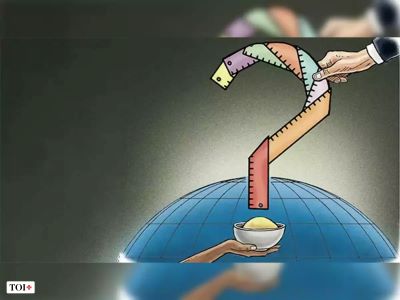Context-
The discussion surrounding poverty in India often hinges on the definition of the poverty line and its implications for assessing poverty levels in the country.
Defining Poverty Line:
● The poverty line in India has evolved over time. According to estimates, the Tendulkar poverty line currently stands at around ₹1,500 in rural areas and ₹1,800 in urban areas. This figure suggests a significant reduction in poverty rates, from 12.5% in 2011-12 to approximately 2% in 2022-23. However, this reduction doesn't signify the eradication of poverty but underscores the necessity of revising the poverty line to reflect changing economic realities.
● The absence of a formally declared income poverty line by the Indian government further complicates the assessment of poverty levels. The conceptual inadequacies of the Tendulkar line, which departed from traditional calorie-based approaches, raise questions about the reliability of poverty metrics in India.
● Adopting internationally recognized poverty standards, such as the World Bank's lower-middle-income line, could provide a more accurate depiction of poverty rates. Estimates based on rural and urban distinctions suggest poverty rates of approximately 21%.
Discrepancies Between Consumption and Income
● Examining discrepancies between consumption expenditure and income growth provides insight into the complexities of assessing economic progress.
● While consumption expenditure has increased by approximately 2.5 times since 2011-12, concerns arise regarding income growth's correlation. Proponents argue that real per capita consumption has risen by 40% over the past 11 years, supported by wage data indicating a 3.2% annual increase for agricultural workers and robust growth in salaried workers' wages.
● Critics raise concerns about discrepancies in wage growth and consumption patterns, questioning the reliability of government data. They argue that real wage growth has been minimal, with studies indicating less than 1% annual growth since 2017, especially in sectors like construction.
● Critics emphasize that the celebrated increase in employment figures, as per the latest Periodic Labour Force Survey (PLFS), is misleading, as it primarily stems from an increase in unpaid family helpers rather than genuine employment growth. Furthermore, they highlight the rising proportion of unpaid female workers, suggesting stagnant real wage incomes for many households. While real consumption has seen modest growth, critics point out that this primarily benefits the top 10 to 15% of the population, with stagnant demand for mass consumption goods indicating broader economic stagnation. Critics argue that GDP growth is now largely driven by public capital expenditure, as private investment remains subdued due to stagnant mass consumption demand.
Challenges in Data Reliability
● The reliability of data sources becomes a focal point, with skepticism towards the quality and transparency of government and private sector data.
● Concerns about data quality, particularly regarding private sector sources such as the Centre for Monitoring Indian Economy (CMIE), raise questions about the accuracy of statistics depicting female labor force participation.
● They acknowledge concerns about the reliability of government data, citing instances like the non-release of the 2017-18 consumer expenditure survey data due to poor quality. However, proponents refute claims that government data is inherently unreliable, suggesting that private sector data may suffer from similar issues.
● They assert that while data quality is important, it is also essential to recognize the complexity of data interpretation and the potential for politicization. Proponents caution against dismissing government data entirely, arguing that it still provides valuable insights into economic trends and patterns. Additionally, they stress the need for transparency and accountability in data collection and reporting processes to address concerns about data reliability and credibility.
Implications of Changing Consumption Patterns
● Regarding changes in consumption patterns, proponents acknowledge the significance of increased spending on non-basic items. They argue that this trend reflects evolving consumer preferences and can be indicative of economic progress.
● Proponents emphasize the importance of income growth in sustaining consumption patterns, noting that increased spending should ideally be accompanied by rising incomes to ensure sustainable economic development.
● While acknowledging persistent challenges, such as food insecurity highlighted in a recent United Nations report, proponents argue that addressing these challenges requires a multifaceted approach that includes both income growth and targeted interventions to improve access to nutritious food. They underscore the importance of adopting sophisticated indicators, like those used by UN agencies, to assess broader indicators of well-being beyond simple calorie consumption metrics.
Conclusion
In conclusion, the dialogue surrounding poverty in India underscores the complexities of assessing poverty levels and economic progress. While official statistics suggest significant reductions in poverty rates and increased consumption expenditure, concerns about data reliability, income disparities, and the adequacy of poverty metrics call for a more nuanced understanding of economic development. Prioritizing inclusive growth strategies that address broader socio-economic factors is essential for achieving sustainable and equitable development in India.
|
Probable Questions for UPSC Mains Exam- 1. Discuss the evolution of the poverty line in India and its implications for assessing poverty levels. How does the absence of a formally declared income poverty line by the Indian government affect poverty metrics in the country? (10 Marks, 150 Words) 2. Analyze the discrepancies between consumption expenditure and income growth in India. How do proponents and critics interpret these disparities, and what are the implications for understanding economic progress and poverty alleviation efforts? (15 Marks, 250 Words) |
Source-The Hindu







